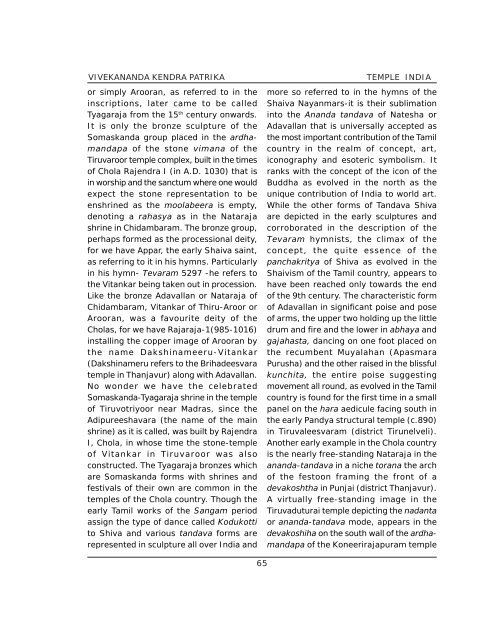Temples In India-1.pdf - Vivekananda Kendra Prakashan
Temples In India-1.pdf - Vivekananda Kendra Prakashan
Temples In India-1.pdf - Vivekananda Kendra Prakashan
Create successful ePaper yourself
Turn your PDF publications into a flip-book with our unique Google optimized e-Paper software.
VIVEKANANDA KENDRA PATRIKAor simply Arooran, as referred to in theinscriptions, later came to be calledTyagaraja from the 15 th century onwards.It is only the bronze sculpture of theSomaskanda group placed in the ardhamandapaof the stone vimana of theTiruvaroor temple complex, built in the timesof Chola Rajendra I (in A.D. 1030) that isin worship and the sanctum where one wouldexpect the stone representation to beenshrined as the moolabeera is empty,denoting a rahasya as in the Natarajashrine in Chidambaram. The bronze group,perhaps formed as the processional deity,for we have Appar, the early Shaiva saint,as referring to it in his hymns. Particularlyin his hymn- Tevaram 5297 -he refers tothe Vitankar being taken out in procession.Like the bronze Adavallan or Nataraja ofChidambaram, Vitankar of Thiru-Aroor orArooran, was a favourite deity of theCholas, for we have Rajaraja-1(985-1016)installing the copper image of Arooran bythe name Dakshinameeru-Vitankar(Dakshinameru refers to the Brihadeesvaratemple in Thanjavur) along with Adavallan.No wonder we have the celebratedSomaskanda-Tyagaraja shrine in the templeof Tiruvotriyoor near Madras, since theAdipureeshavara (the name of the mainshrine) as it is called, was built by RajendraI, Chola, in whose time the stone-templeof Vitankar in Tiruvaroor was alsoconstructed. The Tyagaraja bronzes whichare Somaskanda forms with shrines andfestivals of their own are common in thetemples of the Chola country. Though theearly Tamil works of the Sangam periodassign the type of dance called Kodukottito Shiva and various tandava forms arerepresented in sculpture all over <strong>In</strong>dia andTEMPLE INDIAmore so referred to in the hymns of theShaiva Nayanmars-it is their sublimationinto the Ananda tandava of Natesha orAdavallan that is universally accepted asthe most important contribution of the Tamilcountry in the realm of concept, art,iconography and esoteric symbolism. Itranks with the concept of the icon of theBuddha as evolved in the north as theunique contribution of <strong>In</strong>dia to world art.While the other forms of Tandava Shivaare depicted in the early sculptures andcorroborated in the description of theTevaram hymnists, the climax of theconcept, the quite essence of thepanchakritya of Shiva as evolved in theShaivism of the Tamil country, appears tohave been reached only towards the endof the 9th century. The characteristic formof Adavallan in significant poise and poseof arms, the upper two holding up the littledrum and fire and the lower in abhaya andgajahasta, dancing on one foot placed onthe recumbent Muyalahan (ApasmaraPurusha) and the other raised in the blissfulkunchita, the entire poise suggestingmovement all round, as evolved in the Tamilcountry is found for the first time in a smallpanel on the hara aedicule facing south inthe early Pandya structural temple (c.890)in Tiruvaleesvaram (district Tirunelveli).Another early example in the Chola countryis the nearly free-standing Nataraja in theananda-tandava in a niche torana the archof the festoon framing the front of adevakoshtha in Punjai (district Thanjavur).A virtually free-standing image in theTiruvaduturai temple depicting the nadantaor ananda-tandava mode, appears in thedevakoshiha on the south wall of the ardhamandapaof the Koneerirajapuram temple65
















